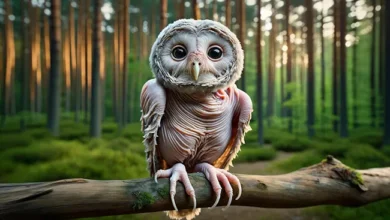
Deer, belonging to the family Cervidae, represent a diverse group of hoofed ruminants characterized by their iconic antlers and distinctive foot structure. With 43 recognized species, deer are renowned for their adaptability and widespread distribution across the globe, inhabiting all continents except Australia and Antarctica. While most species thrive under protection and careful management, some face endangerment, particularly those found in swamp and island habitats. Despite their natural elegance, certain species, like the white-tailed deer of North America, have transitioned from cherished game animals to urban pests. Despite occasional misapplications of the term “deer” to non-cervid species like musk deer and mouse deer, the family Cervidae remains a cohesive and natural grouping, reflecting the remarkable diversity and evolutionary history of these enchanting creatures.
Morphology and behaviour
The morphology and behavior of deer reveal fascinating adaptations that contribute to their success as herbivorous ruminants. In nearly all species, males boast impressive antlers, used primarily for mating displays and territorial defense. However, the reindeer stands apart, as both males and females bear antlers, a unique trait among cervids. Conversely, the Chinese water deer presents an intriguing exception, lacking antlers altogether and instead possessing long, sharp upper canines known as tusks, reminiscent of an earlier pre-antler condition observed in the fossil record. Some species exhibit a combination of antlers and tusks, showcasing a progression of increased antler size alongside a reduction in the size and functional structure of the tusks. Additionally, deer possess several distinctive anatomical features, including the absence of a gall bladder and the presence of four teats in females. While scent glands may be present on their legs, deer notably lack rectal, vulval, or preputal glands.
Furthermore, deer are specialized herbivores, as evidenced by their large and complex digestive organs, mobile lips, and specialized teeth. Unlike some other herbivores, deer display a preference for selective feeding, focusing on a diverse array of plant materials ranging from young grasses and herbs to lichens, foliage, buds, aquatic plants, woody shoots, and fruits. They exhibit a remarkable ability to identify and consume plant food characterized by low fiber but high protein content, toxicity, and digestibility, demonstrating their adaptability to varying dietary needs and environmental conditions. Despite their reliance on selective feeding, deer have not evolved grazing specializations comparable to those found in bovids, reflecting their unique dietary preferences and ecological niche within terrestrial ecosystems.
Red Deer
The remarkable growth and shedding cycle of deer antlers are intricately tied to their ecological niche and dietary preferences. Antlers, often referred to as “bone horns,” serve as vital weapons and display organs in combat and courtship rituals, respectively. Encased in a highly vascularized, nerve-filled skin known as velvet during their growth phase, antlers require an immense amount of minerals, protein, and energy. This demand for nutrients drives deer to seek out high-quality food sources, typically found in nutrient-rich dicotyledonous plants. The growth process, lasting up to 150 days, culminates in the shedding of the velvet, leaving behind brownish residues on the otherwise white antler bone.
This requirement for nutrients and energy has profound implications for the ecology of deer, dictating their habitat preferences and distribution. Deer are confined to relatively productive habitats, excluding them from nutrient-poor landscapes such as deserts and dry grasslands. Furthermore, the demand for high-quality food limits their abundance in mature, species-rich faunas where competition for resources is intense. To meet their nutritional needs, deer have evolved specialized adaptations to exploit disturbed ecosystems, such as those created by forest fires or annual flooding events. These disturbances result in the rapid succession of plant communities, providing deer with abundant food sources during early plant successions.
The evolutionary history of deer is intricately linked to environmental upheavals, such as the extreme climatic oscillations of the Ice Ages. Glacial activity led to the formation of nutrient-rich soils, favoring the expansion and diversification of deer populations into colder, more seasonal landscapes. This diversification resulted in the emergence of grotesque giants with elaborate coat patterns and large, bizarre antlers, adapted to exploit the resources of their respective habitats.
Despite broad similarities in food habits, deer exhibit highly divergent antipredator strategies, further segregating species ecologically and minimizing competition. From hiding and rapid evasion tactics to specialized running and cliff climbing abilities, deer have evolved a range of strategies to evade predators and maximize their chances of survival in diverse habitats. These adaptations highlight the evolutionary ingenuity of deer in navigating the complex interplay between predator pressure and ecological constraints.
Old and New World deer
Within the family Cervidae, a notable division exists between the Old World deer, classified under the subfamily Cervinae, and the New World deer, categorized as members of the subfamily Capreolinae. While this division historically reflected the geographic origins of these deer, it now primarily stems from differences in their foot structures. In Old World deer, the second and fifth hand bones, known as metapodia, have nearly vanished, leaving only proximal, terminal remnants. Conversely, in New World deer, these remnants are distal, highlighting distinct evolutionary trajectories within the family. This divergence underscores the complexity of deer evolution and adaptation to diverse environments, shaping their unique anatomical features and ecological roles across continents.
Old World deer
Old World deer display an extraordinary range of diversity, spanning different regions and ecological adaptations. Originating with the primitive tropical Asian muntjacs, notable for their tusks and tall antler pedicles, the evolutionary journey progresses to tropical and subtropical deer with a basic three-pronged antler structure. Among these, impressive species include the imposing sambar of India and the sociable chital of India and Sri Lanka. Additionally, a myriad of smaller island species, such as the Bawean deer of Indonesia and the Calamian deer of the Philippines, demonstrate remarkable adaptation to varied habitats while retaining the essential “deer design.”
Transitioning to temperate zones, Old World deer with a four-pronged antler structure, like the sika of Japan and the fallow deer of Asia Minor, thrive. The fallow deer, last among the survivors of a lineage of giant Pleistocene deer, is particularly noteworthy, reminiscent of the awe-inspiring Irish elk, which weighed a staggering 600 kg (1,300 pounds) and boasted antlers spreading up to 4 meters (14 feet) in width. This rich diversity is further complemented by the inclusion of the white-lipped deer of the Tibetan Plateau and Père David’s deer, which inhabit the swamps along China’s major rivers, completing the category of Old World deer.
New World deer
New World deer have a rich history, originating from a distinct radiation that ventured into North and South America alongside Eurasia. During the Ice Age, a remarkable array of species evolved, including towering giants like the moose, standing over 2 meters (7 feet) tall at the shoulder, and the agile reindeer, known for its prowess in plains running and relatively large antlers. In the cold climates of Eurasia, the diminutive Eurasian roe deer and the antlerless Chinese water deer of Korea and China adapted to survive.
In the Americas, the adaptable white-tailed deer became ubiquitous, colonizing both continents, while its close relative, the mule deer, thrived in the western regions of North America. Venturing further south, dwarf brocket deer can be found from Mexico all the way down to Argentina, showcasing the diversity of deer species across the continent. Among the smallest deer species are the pudu, standing a mere 30 cm (12 inches) at the shoulder, with two distinct species residing in the central Andes and southern Chile. Meanwhile, the Andean deer, adept at climbing rocky terrain, are found in separate habitats across the Andes.
South America is also home to endangered species like the diminutive pampas deer and the marsh deer, comparable in size to the red deer, highlighting the need for conservation efforts to protect these unique and threatened creatures. Overall, the New World deer exhibit a fascinating range of adaptations and ecological niches, reflecting the diverse landscapes they inhabit.
Père David’s deer
Père David’s deer, scientifically known as Elaphurus davidianus, is a majestic and rare Asian deer belonging to the family Cervidae within the order Artiodactyla. Remarkably, it stands as the sole member of its genus and holds a fascinating history shrouded in mystery. Believed to have been native to northern China, this magnificent creature is now exclusively found within the confines of zoos, private animal collections, and game reserves.
Characterized by its imposing stature, Père David’s deer stands approximately 1.1 meters (43 inches) tall at the shoulder. Its robust physique is accentuated by heavy legs, broad hooves, and relatively small ears, all complemented by a strikingly long, bushy tail. The deer’s coat undergoes seasonal transformations, ranging from a reddish-brown hue in summer to a uniform grayish-brown shade in winter, adding to its allure.
Notably, the male of this species boasts impressive antlers that fork shortly above the base.With the front prong branching once and the rear prong extending backward, unbranched. Historical records indicate that the only known population of Père David’s deer in the 19th century. Resided in a herd maintained for the Chinese emperor within a game park near Beijing. It was in 1865 that French missionary Armand David first laid eyes on this captivating creature, With specimens later classified by the esteemed French naturalist Henri Milne-Edwards in the subsequent year.
Tragically, the majority of the Chinese herd met a grim fate during a devastating flood in 1895. While the remaining deer fell victim to the turmoil of the Boxer Rebellion in 1900. However, hope persisted as a breeding population was established at Woburn Abbey in England. Under the attentive care of the duke of Bedford. Flourishing in captivity, Père David’s deer thrived, and efforts to conserve the species saw successful reintroductions. Such as the 20 animals reintroduced to China in 1985. Leading to a remarkable population growth to 2,000 individuals after two decades.
Today, Père David’s deer continues to enchant and inspire awe in audiences worldwide. Serving as a testament to the resilience of nature. And the dedication of conservationists in safeguarding endangered species for generations to come.
Fallow deer
Fallow deer, scientifically known as Dama dama, are a medium-sized species of deer. Belonging to the family Cervidae within the order Artiodactyla. Renowned for their elegance and adaptability, they are commonly found in estates, parks, and zoos worldwide. The common fallow deer, native to the eastern Mediterranean, has a counterpart. The larger and more vibrantly colored Mesopotamian fallow deer, indigenous to Iran. Since the Neolithic Period, these deer have been introduced to various regions. And now thrive both in the wild, particularly in Europe, and in captivity on deer farms across the globe.
Standing at about 90 cm (3 feet) at the shoulder, with bucks weighing up to 100 kg (220 pounds). And females around 45 kg (100 pounds), fallow deer prefer open woodland habitats. Where they primarily feed on herbs, foliage, and occasionally woody browse and grasses. Their coat displays a characteristic yellowish-brown hue with white spots in summer. Transitioning to a more uniformly grayish-brown shade in winter. When faced with predators, fallow deer utilize a distinctive stiff-legged jumping and running technique known as stotting to evade danger.
Fallow deer hold a special place in the lineage of deer, being the sole survivors of the Megacerines. A diverse deer lineage that thrived during the Ice Ages. Notably, fallow bucks boast the largest antlers among Old World deer. With flat antlers measuring about 60 cm (2 feet) long. During the rutting season, bucks engage in elaborate courtship displays, waving their antlers towards females while emitting loud vocalizations. Dominant males establish breeding territories, utilizing scent markings to attract females.
The rut peaks in October, with females giving birth to a single fawn after a gestation period of approximately 235 days. Females and young typically form groups, while males remain solitary except during the breeding season. Unfortunately, Mesopotamian fallow deer, inhabiting riverbanks in desert regions. Face severe endangerment, with only a few individuals remaining in the wild. Efforts to conserve these magnificent creatures are crucial to ensuring their survival in the face of mounting threats.
Red deer
The red deer, scientifically known as Cervus elaphus, is a renowned member of the deer family. Cervidae, belonging to the order Artiodactyla. Native to diverse regions including North America, Europe, Asia, and northwestern Africa, it has also been introduced into New Zealand. Revered for its majestic presence and significance in both hunting and culinary traditions. The red deer has long been pursued for sport and sustenance.
Preferring woodlands as its primary habitat, the red deer typically forms sexually segregated herds. Except during the breeding season, when males, known as harts. Engage in fierce battles for the opportunity to mate with groups of females, known as hinds. Towering at approximately 1.2 meters (4 feet) tall at the shoulder, the red deer cuts an imposing figure. Its coat, characterized by a reddish-brown hue, transitions to a darker grayish-brown shade in winter. Complemented by lighter underparts and a pale rump.
One of the most striking features of the red deer is its impressive antlers, which are long and regularly branched, bearing a total of 10 or more tines. Particularly noteworthy are individuals with 12 or 14 tines, known respectively as “Royals” and “Wilsons.” While the International Union for Conservation of Nature classifies the red deer as a species of least concern. It highlights the vulnerability of some subspecies, with approximately 20 subspecies facing threats due to hunting pressure and habitat loss. Moreover, interbreeding with nonnative red deer subspecies has contributed to the decline of certain populations, particularly in North America and Eurasia.
Among the subspecies, the elk, or wapiti (Cervus elaphus canadensis). Stands out as the largest, showcasing the remarkable diversity within the red deer species. As stewards of conservation, efforts must be intensified to safeguard the red deer. And its subspecies, ensuring their continued presence and ecological significance for generations to come.
Roe deer
Roe deer, belonging to the genus Capreolus, are charming and diminutive members of the Cervidae family within the order Artiodactyla. With two distinct species, namely the European roe deer (Capreolus capreolus) and the larger Siberian roe deer (C. pygargus). These graceful creatures are synonymous with the landscapes of Eurasia. Despite their Old World distribution, roe deer share a closer evolutionary relationship with New World deer than with other Old World deer species.
Adapted to thrive in cold environments, roe deer inhabit a vast range extending from northern Europe. And Asia into the lofty mountains of Central Asia, with some populations reaching as far south as Spain. The roe deer’s coat undergoes seasonal changes, with a reddish-brown hue in summer. And a grayish-brown coloration accentuated by a conspicuous white rump patch in winter.
Distinctive features of the male roe deer include short, usually three-tined antlers that are roughened. And enlarged at the base, likely serving as protection against potential antler punctures to the skull. Despite their diminutive size, the European roe deer stands at an average height of 66–86 cm (26–34 inches) at the shoulder and seldom exceeds 30 kg (66 pounds) in weight. In contrast, Siberian roe bucks tend to be larger, weighing approximately 50 kg (110 pounds).
As an almost tailless species, roe deer exhibit a delicate and agile demeanor. Perfectly suited to navigating their woodland habitats with grace and stealth. Their presence adds a touch of enchantment to the natural landscapes they inhabit, captivating observers with their elegance. And resilience in the face of changing seasons and environmental challenges.
Frequently Asked Questions (FAQ) About Deer
1. What are three facts about deer?
- Deer belong to the family Cervidae and are widespread hoofed mammals found across the globe. Inhabiting diverse habitats from forests to grasslands.
- Male deer, known as bucks, typically grow antlers, which are shed and regrown annually. These antlers serve primarily for mating rituals and displays of dominance.
- Deer possess keen senses, including excellent hearing and a strong sense of smell. Aiding them in detecting predators and finding food sources.
2. What are female deer called?
- Female deer are called does.
3. How do you describe a deer?
- A deer is typically described as a graceful, hoofed mammal with a slender body. Long legs, and distinctive antlers in males. They usually have a reddish-brown coat, sometimes adorned with white spots, and are known for their cautious and skittish behavior.
4. Why do we call them deer?
- The term “deer” originates from the Old English word “deor,” which originally referred to any wild animal. Over time, it became specifically associated with members of the Cervidae family. Including deer species, due to their widespread presence and cultural significance worldwide.
Do Deer Eat Pumpkins?
Yes, deer are known to eat pumpkins. Pumpkins are a seasonal treat for deer, especially in the fall when they are readily available. Deer are attracted to the sweet taste and high moisture content of pumpkins, making them a popular snack in areas. Where deer populations overlap with agricultural fields or pumpkin patches. However, it’s important for farmers and gardeners to take precautions to protect their crops from deer damage if they want to preserve their pumpkins for other uses. Read more about does deer eat pumpkins.




